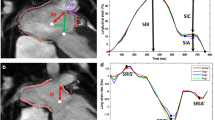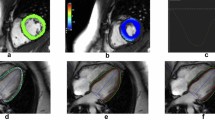Abstract
The influence of visceral adiposity on left ventricular remodeling following coronary artery disease (CAD)-related events has not been examined to date. Using magnetic resonance imaging (MRI) we explored intra-thoracic fat volume (ITFV) and strain-based markers of adverse remodeling in patients with CAD. Forty-seven patients with known CAD (25 with prior MI, 22 without prior MI) were studied. ITFV was quantified using previously validated imaging techniques. Myocardial strain was derived from cine MRI using a validated 3D feature-tracking (FT) software. Segmental LGE quantification was performed and was used to incrementally constrain strain analyses to non-infarcted (i.e. remote) segments. Remote myocardial strain was compared to the non-MI control cohort and was explored for associations with ITFV. Mean age was 57 ± 13 years with a mean BMI of 30.0 ± 6.2 kg/m2 (range 20.3–38.4 kg/m2). Patients with versus without prior MI had similar demographics and BMI (29.4 ± 4.4 vs. 30.4 ± 7.9 kg/m2, p = 0.62). Patients with prior MI had lower mean peak strain than non-MI patients (p = 0.02), consistent with remote tissue contractile dysfunction. Inverse associations were identified between ITFV and mean peak strain in both the MI group (circumferential: r = 0.43, p = 0.03; radial: − 0.41, p = 0.04; minimum principal: r = 0.41, p = 0.04; maximum principal: r = − 0.43, p = 0.03) and non-MI group (circumferential: r = 0.42, p = 0.05; minimum principal: r = 0.45, p = 0.03). In those with prior MI higher ITFV was associated with a greater reduction in remote tissue strain. ITFV is associated with contractile dysfunction in patients with CAD. This association is prominent in the post-MI setting suggesting relevant influence on remote tissue health following ischemic injury. Expanded study of intra-thoracic adiposity as a modulator of myocardial health in patients with CAD is warranted.




Similar content being viewed by others
Abbreviations
- BMI:
-
Body mass index
- BSA:
-
Body surface area
- CABG:
-
Coronary artery bypass graft
- CAD:
-
Coronary artery disease
- CMR:
-
Cardiac magnetic resonance
- HDL:
-
High density lipoproteins
- ICC:
-
Intra-class correlation
- ITFV:
-
Intra-thoracic fat volume
- GFR:
-
Glomerular filtration rate
- LDL:
-
Low density lipoproteins
- LGE:
-
Late gadolinium enhancement
- LV:
-
Left ventricle
- LVEDV:
-
Left ventricular end-diastolic volume
- LVEDVI:
-
Left ventricular end-diastolic volume index
- LVEF:
-
Left ventricular ejection fraction
- LVM:
-
Left ventricular mass
- LVMI:
-
Left ventricular mass index
- LVESVI:
-
Left ventricular end-systolic volume index
- MI:
-
Myocardial infarction
- MRI:
-
Magnetic resonance imaging
- PCI:
-
Percutaneous coronary intervention
References
Hubert HB, Feinleib M, McNamara PM, Castelli WP (1983) Obesity as an independent risk factor for cardiovascular disease: a 26-year follow-up of participants in the Framingham Heart Study. Circulation 67:968–977
Mokdad AH, Ford ES, Bowman BA et al (2003) Prevalence of obesity, diabetes, and obesity-related health risk factors, 2001. JAMA 289:76–79
Coutinho T, Goel K, Corrêa de Sá D et al (2011) Central obesity and survival in subjects with coronary artery disease: a systematic review of the literature and collaborative analysis with individual subject data. J Am Coll Cardiol 57:1877–1886. https://doi.org/10.1016/j.jacc.2010.11.058
Okorodudu DO, Jumean MF, Montori VM et al (2010) Diagnostic performance of body mass index to identify obesity as defined by body adiposity: a systematic review and meta-analysis. Int J Obes 34:791–799. https://doi.org/10.1038/ijo.2010.5
Flint AJ, Rimm EB (2006) Commentary: Obesity and cardiovascular disease risk among the young and old–is BMI the wrong benchmark? Int J Epidemiol 35:187–189. https://doi.org/10.1093/ije/dyi298
Lau DCW, Dhillon B, Yan H et al (2005) Adipokines: molecular links between obesity and atheroslcerosis. Am J Physiol Heart Circ Physiol 288:H2031–H2041. https://doi.org/10.1152/ajpheart.01058.2004
Chen O, Sharma A, Ahmad I et al (2015) Correlation between pericardial, mediastinal, and intrathoracic fat volumes with the presence and severity of coronary artery disease, metabolic syndrome, and cardiac risk factors. Eur Heart J Cardiovasc Imaging 16:37–46. https://doi.org/10.1093/ehjci/jeu145
Patil HR, Patil NT, King SI et al (2014) Increased intrathoracic and hepatic visceral adipose tissue independently correlates with coronary artery calcification in asymptomatic patients. J Nucl Cardiol 21:880–889. https://doi.org/10.1007/s12350-014-9946-9
Jolly US, Soliman A, McKenzie C et al (2013) Intra-thoracic fat volume is associated with myocardial infarction in patients with metabolic syndrome. J Cardiovasc Magn Reson 15:77. https://doi.org/10.1186/1532-429X-15-77
Fox CS, Gona P, Hoffmann U et al (2009) Pericardial fat, intrathoracic fat, and measures of left ventricular structure and function: the Framingham Heart Study. Circulation 119:1586–1591. https://doi.org/10.1161/CIRCULATIONAHA.108.828970
Alpert MA (2001) Obesity cardiomyopathy: pathophysiology and evolution of the clinical syndrome. Am J Med Sci 321:225–236
Abel ED (2011) Obesity stresses cardiac mitochondria even when you are young. J Am Coll Cardiol 57:586–589. https://doi.org/10.1016/j.jacc.2010.09.039
Ku CS, Lin SL, Wang DJ et al (1994) Left ventricular filling in young normotensive obese adults. Am J Cardiol 73:613–615
Alexander JK, Dennis EW, Smith WG et al Blood volume, cardiac output, and distribution of systemic blood flow in extreme obesity. Cardiovasc Res Cent Bull 1:39–44
Ng ACT, Goo SY, Roche N et al (2016) Epicardial adipose tissue volume and left ventricular myocardial function using 3-dimensional speckle tracking echocardiography. Can J Cardiol 32:1485–1492. https://doi.org/10.1016/j.cjca.2016.06.009
Center for Drug Evaluation and Research Drug Safety and Availability - FDA Drug Safety Communication: New warnings for using gadolinium-based contrast agents in patients with kidney dysfunction
Kim RJ, Shah DJ, Judd RM (2003) How we perform delayed enhancement imaging. J Cardiovasc Magn Reson 5:505–514
Satriano A, Heydari B, Narous M et al (2015) 4-Dimensional left ventricular strain analysis by cardiovascular magnetic resonance imaging: validation versus 4D speckle tracking echocardiography. Can J Cardiol 31:S70–S71. https://doi.org/10.1016/j.cjca.2015.07.162
Satriano A, Rivolo S, Martufi G et al (2015) In vivo strain assessment of the abdominal aortic aneurysm. J Biomech 48:354–360. https://doi.org/10.1016/j.jbiomech.2014.11.016
Satriano A, Heydari B, Narous M et al (2017) Clinical feasibility and validation of 3D principal strain analysis from cine MRI: comparison to 2D strain by MRI and 3D speckle tracking echocardiography. Int J Cardiovasc Imaging 33:1979–1992. https://doi.org/10.1007/s10554-017-1199-7
Mikami Y, Kolman L, Joncas SX et al (2014) Accuracy and reproducibility of semi-automated late gadolinium enhancement quantification techniques in patients with hypertrophic cardiomyopathy. J Cardiovasc Magn Reson 16:85. https://doi.org/10.1186/s12968-014-0085-x
Mahabadi AA, Massaro JM, Rosito GA et al (2009) Association of pericardial fat, intrathoracic fat, and visceral abdominal fat with cardiovascular disease burden: the Framingham Heart Study. Eur Heart J 30:850–856. https://doi.org/10.1093/eurheartj/ehn573
Ding J, Hsu F-C, Harris TB et al (2009) The association of pericardial fat with incident coronary heart disease: the Multi-Ethnic Study of Atherosclerosis (MESA). Am J Clin Nutr 90:499–504. https://doi.org/10.3945/ajcn.2008.27358
Sharma AM (2002) Adipose tissue: a mediator of cardiovascular risk. Int J Obes Relat Metab Disord 26(Suppl 4):S5-S7. https://doi.org/10.1038/sj.ijo.0802210
Peterson LR, Herrero P, Schechtman KB et al (2004) Effect of obesity and insulin resistance on myocardial substrate metabolism and efficiency in young women. Circulation 109:2191–2196. https://doi.org/10.1161/01.CIR.0000127959.28627.F8
Szczepaniak LS, Victor RG, Orci L, Unger RH (2007) Forgotten but not gone: the rediscovery of fatty heart, the most common unrecognized disease in America. Circ Res 101:759–767. https://doi.org/10.1161/CIRCRESAHA.107.160457
Goralski KB, Sinal CJ (2007) Type 2 diabetes and cardiovascular disease: getting to the fat of the matter. Can J Physiol Pharmacol 85:113–132. https://doi.org/10.1139/y06-092
Buchanan J, Mazumder PK, Hu P et al (2005) Reduced cardiac efficiency and altered substrate metabolism precedes the onset of hyperglycemia and contractile dysfunction in two mouse models of insulin resistance and obesity. Endocrinology 146:5341–5349. https://doi.org/10.1210/en.2005-0938
Sutton MGSJ, Sharpe N (2000) Left ventricular remodeling after myocardial infarction: pathophysiology and therapy. Circulation 101:2981–2988. https://doi.org/10.1161/01.CIR.101.25.2981
Mitchell GF, Lamas GA, Pfeffer MA (1993) Ventricular remodeling after myocardial infarction. Adv Exp Med Biol 346:265–276
Hombach V, Merkle N, Bernhard P et al (2010) Prognostic significance of cardiac magnetic resonance imaging: update 2010. Cardiol J 17:549–557
Kramer SP, Powell DK, Haggerty CM et al (2013) Obesity reduces left ventricular strains, torsion, and synchrony in mouse models: a cine displacement encoding with stimulated echoes (DENSE) cardiovascular magnetic resonance study. 15:109
Carrick D, Haig C, Rauhalammi S et al (2015) Pathophysiology of LV remodeling in survivors of STEMI. JACC Cardiovasc Imaging 8:779–789. https://doi.org/10.1016/j.jcmg.2015.03.007
Acknowledgements
Dr. White received salary support from the Heart and Stroke Foundation of Alberta during this study, receives research grant support from the Circle Cardiovascular Inc. and is a shareholder of Cohesic Inc. Dr. Howarth receives consulting fees from Amgen. Dr. Matthias G. Friedrich is Chief Medical Officer of Circle Cardiovascular Inc. Dr. Fine receives consulting fees from Novartis and Pfizer.
Funding
This study was funded by Heart and Stroke Foundation of Alberta.
Author information
Authors and Affiliations
Corresponding author
Ethics declarations
Conflict of interest
Dr. Anna Todd has no conflict of interest. Dr. Alessandro Satriano declares that he has no conflict of interest. Ms. Kate Fenwick declares that she has no conflict of interest. Dr. Naeem Merchant declares that he has no conflict of interest. Dr. Carmen P. Lydell declares that she has no conflict of interest. Dr. Andrew G. Howarth receives consulting fees from Amgen. Dr. Matthias G. Friedrich is Chief Medical Officer of Circle Cardiovascular Inc. Dr. Todd J. Anderson declares that he has no conflict of interest. Dr. Nowell M. Fine receives consulting fees from Novartis and Pfizer. Dr. James A. White received salary support from the Heart and Stroke Foundation during this study, received research grants from Circle Cardiovascular Inc., and is a shareholder of Cohesic Inc.
Ethical approval
All procedures performed in studies involving human participants were in accordance with the ethical standards of the institutional and/or national research committee and with the 1964 Helsinki declaration and its later amendments or comparable ethical standards.
Research involved in human or animal rights
This article does not contain any studies with animals performed by any of the authors.
Informed consent
Informed consent was obtained from all individual participants included in the study.
Electronic supplementary material
Below is the link to the electronic supplementary material.
Rights and permissions
About this article
Cite this article
Todd, A., Satriano, A., Fenwick, K. et al. Intra-thoracic adiposity is associated with impaired contractile function in patients with coronary artery disease: a cardiovascular magnetic resonance imaging study. Int J Cardiovasc Imaging 35, 121–131 (2019). https://doi.org/10.1007/s10554-018-1430-1
Received:
Accepted:
Published:
Issue Date:
DOI: https://doi.org/10.1007/s10554-018-1430-1




